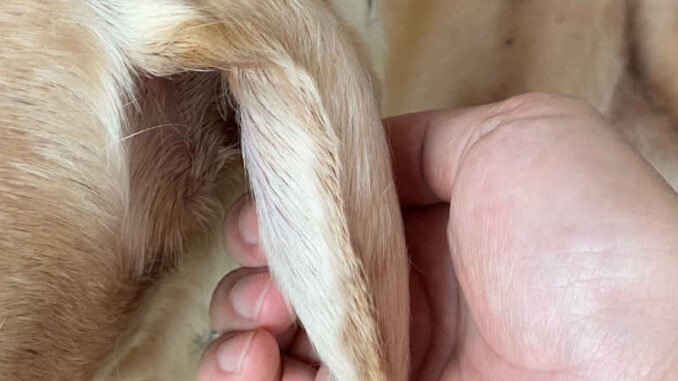
This article was updated on February 7th, 2024
It can be alarming to rub your dog’s ear and feel a puffy, fluid-filled ear that once was soft and smooth. His ear suddenly looks and feels a bit like a thickened water balloon. This may be an ear hematoma – a common condition seen in veterinary clinics nationwide.
If your dog has a hematoma, the ear will appear swollen and doughy, almost like a thick water balloon.
It has this appearance because it is a blood-filled swelling between the skin and cartilage layers of the earflap. It can affect the whole earflap or just part. You can view more pictures here.
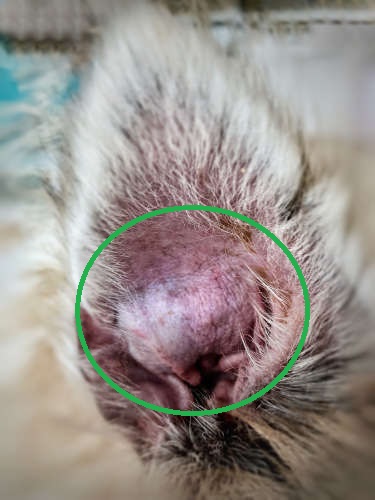
Ear hematomas can be very painful
You may notice your dog is sensitive around the head and ears if he has a hematoma. This pain is caused by pressure and fluid buildup between the skin and cartilage. Some signs your dog may be uncomfortable or in pain include:
- Ear scratching
- Headshaking
- Head tilt
- Sensitivity around ears – flinching, pulling away when touched, biting
Ear hematomas are often caused by injuries, ear infections, ear mites, or even allergies
An ear hematoma occurs when a blood vessel inside the earflap ruptures. Since there is nowhere for the blood to drain, the space between the skin and the cartilage fills with blood and becomes swollen and painful. Ear hematomas are often the result of a medical issue – they can be caused by trauma, ear infections, ear mites, or even allergies.
The Royal Veterinary College recently published a study that may provide a new theory on ear hematomas and their causes. They suspect dogs with folded cartilage earflaps may be more at risk based on the anatomy of the folded ear. They hypothesized that the cartilage is weakened and chronically damaged, resulting in bleeding.
Symptoms
- You may initially notice your dog scratching his ears or shaking his head excessively.
- Some dogs will even tilt their head to one side when one of their ears bothers them.
- Swelling or puffiness on the ear flap.
If you have any concerns that your dog may be developing an ear hematoma, try feeling the opposite ear. It is very unusual for a dog to have hematomas on both ears simultaneously. Feel each ear to compare. Does one feel thicker or puffier than the other?
Quick veterinary treatment helps prevent permanent damages to the ear
Ideally, your dog’s ear hematoma should be treated by a vet as soon as you notice it. Hematomas can be very painful, especially when left untreated. They may also get smaller and suddenly refill with blood, which delays healing.
It can take a few months for the body to reabsorb the blood in the earflap. Untreated hematomas don’t always heal nicely either – they can have scar tissue formation that leads to a cauliflower ear (similar to wrestler’s ear, where the ear becomes deformed due to fibrosis and scarring).
Home remedies
After you have talked to your vet to confirm the correct diagnosis and treatment approach, you may consider the following:
1. Treat any underlying causes
Treat the ear infection or ear mites. Make sure skin allergies and flare-ups are under control. This may include medicated or non-medicated ear cleaners, ear drops, oral steroids, or other allergy medications. All these therapies can help address the root cause of the hematoma, give your dog some itch relief, and allow the hematoma to start healing.
2. Protect the affected ear
This may mean a cone to keep your dog from scratching and causing further pain and swelling. Your vet may want to bandage the ear.

You can also talk to your vet about a No Flap Ear Wrap or other ear wrap alternative. The goal with any of these is to protect the painful, swollen skin from further trauma or cuts that might introduce infection. Read our article: Dog Ear Hematoma Wraps: A Dog Owner’s Guide or Home Remedies for Hematomas (to work on in partnership with your veterinarian).
When to see the vet / when to monitor the situation at home
A small hematoma not affecting the whole earflap may resolve on its own without a visit to the vet’s office. Monitor the affected ear closely though – if it gets worse, it is essential to schedule an appointment as soon as possible. If you have any doubt, you can call your vet or email them pictures to ask for feedback.
If the hematoma affects the entire ear flap or the swelling covers the ear canal, you should have your dog seen by the vet asap
Most of the time, your vet can diagnose an ear hematoma just by visually inspecting the ear. They may need additional tests like ear swabs to determine if there is an underlying cause, like an infection or parasite. Ear swabs are typically inexpensive and done in-house, meaning you often get results that day.
Treatment options
1. Needle aspiration
This is typically the least invasive and least expensive approach to treating an ear hematoma. This procedure involves inserting a sterile needle into the swelling to drain the blood. Many vets inject a small amount of steroid into the space. Your dog may need oral steroids for a few weeks as well. This nonsurgical drainage typically does not require anesthesia.
There are some drawbacks to this therapy though. The earflap space can refill with blood very quickly, meaning the procedure may need to be repeated multiple times. There is also a risk of introducing infection.
2. Surgical options
There are many surgical approaches to draining a hematoma, including a straight incision, an S-shaped incision with sutures, or a drain sewn into the earflap. There is even an approach that makes tiny holes in the skin to allow blood to drain called punch biopsy technique. Sometimes these procedures can be done with heavy sedation, but most will need general anesthesia.
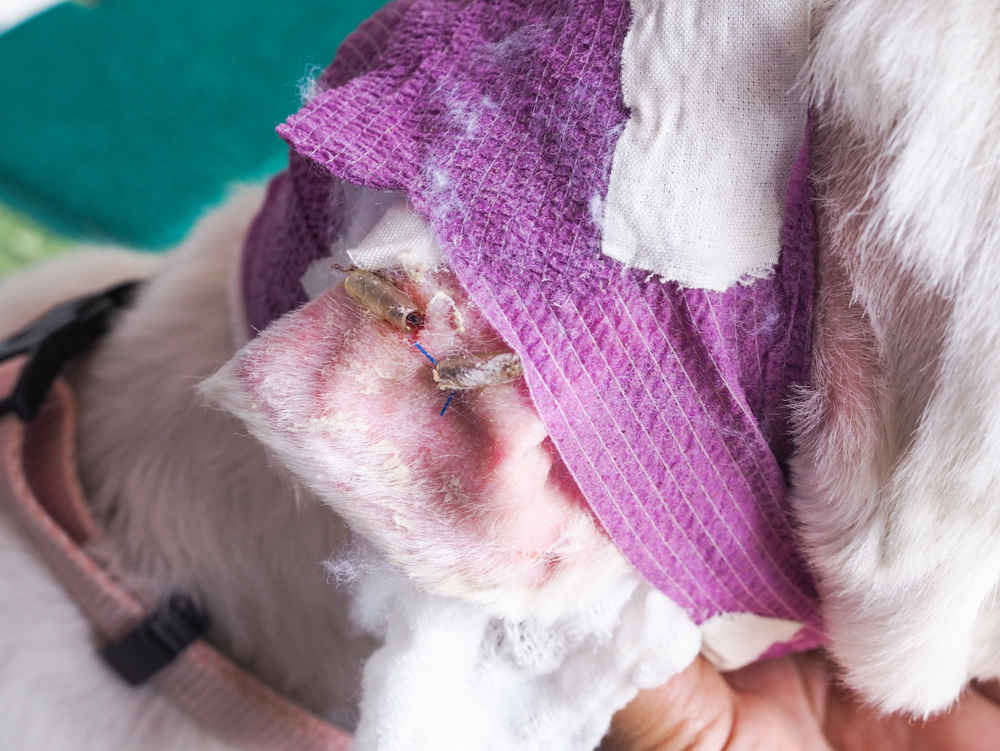
Surgical options tend to be more expensive, especially if anesthesia is required.
Prognosis
When treated, most dogs will fully recover from an ear hematoma within a few weeks. The sooner treatment is initiated, the sooner your dog will feel better, and the hematoma will start to heal. There is also decreased risk of scarring like cauliflower ear when the hematoma is treated early.
FAQs
Can a Dog Ear Hematoma Burst?
It is possible, although unlikely, for an ear hematoma to burst or pop. You will know it though because blood and clots will come out of the ear, especially when your dog shakes his head. It can be quite a messy situation! If this does happen, it is best to have your dog seen by a veterinarian to help manage and treat it.
Can an Ear Hematoma Kill a Dog?
An ear hematoma is unlikely to kill your dog, but it may be immensely painful. If left untreated, it can continue for months. Read our article: Can Ear Hematomas Kill a Dog? Our Vet Explains the Risks.
Why Does My Dog Keep Getting Hematomas?
There may be an underlying cause for repeat offender cases. Often dogs that are prone to allergies or ear infections are more likely to develop hematomas.
Sometimes anatomy can play a role as well. Dogs with folded ears have a higher risk of developing hematomas. Bull terriers, St. Bernards, and French bulldogs appear to have a 5-7 times higher likelihood of developing hematomas than other breeds with erect, upright ears.
How Do You Know if a Dog Hematoma Needs to be Drained?
If the hematoma is covering your dog’s ear canal, taking up the whole earflap, or seems painful, it likely needs to be drained.
Is a Hematoma a Blood Clot?
An ear hematoma is a pooling of blood underneath the skin of the ear. It can form clots in the ear, which causes the swelling to feel firmer. Clots can also make it harder to drain with a needle since they cannot be pulled out through a syringe.
Can a Hematoma Come Back After Being Drained?
Ear hematomas are notorious for coming back despite being drained. This is especially true with needle aspiration since the space is not closed with sutures. Typically, dogs may require 2-3 rounds of needle aspiration to remove the blood; with surgical correction, the hematoma is far less likely to recur.
Disclaimer: This website's content is not a substitute for veterinary care. Always consult with your veterinarian for healthcare decisions. Read More.



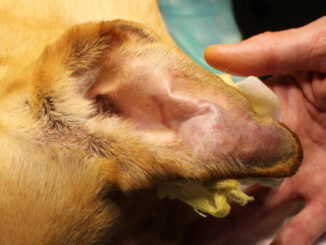
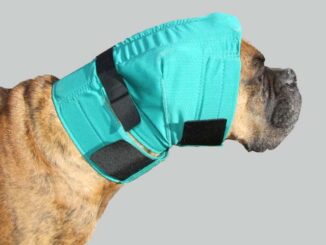
Be the first to comment